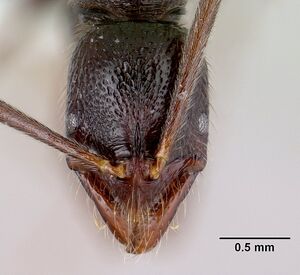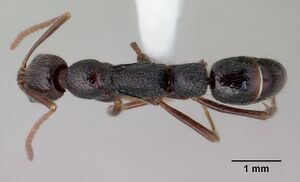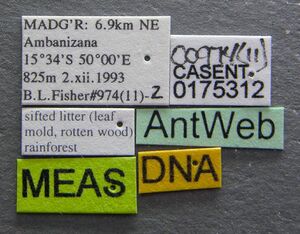Leptogenys avo
| Leptogenys avo | |
|---|---|

| |
| Scientific classification | |
| Kingdom: | Animalia |
| Phylum: | Arthropoda |
| Class: | Insecta |
| Order: | Hymenoptera |
| Family: | Formicidae |
| Subfamily: | Ponerinae |
| Tribe: | Ponerini |
| Genus: | Leptogenys |
| Species group: | toeraniva |
| Species: | L. avo |
| Binomial name | |
| Leptogenys avo Rakotonirina & Fisher, 2014 | |
The two worker specimens of L. avo were from high altitude localities in eastern Madagascar. They were found foraging in the leaf litter of montane rainforest.
Identification
A member of the toeraniva species group. Rakotonirina and Fisher (2014) - Worker. Mandible capable of closing tightly against clypeus; eye not flattened, slightly protruding from head capsule; antennal scape with erect hairs shorter than maximum width of scape; eye larger, maximum diameter greater than the maximum width of scape. Propodeal declivity transversely striate; in profile, anterodorsal and posterodorsal margin of petiolar node at the same height and helcium located approximately near mid-height of anterior margin of third abdominal segment. Prora voluminous and anteroventral section of third abdominal sternite rounded; prora and anteroventral angle separated by strong indentation.
This species is known from two specimens, one from each of two sites. The specimen from PN Masoala has eye diameter roughly as large as the greatest width of the scape; petiolar node in profile approximately as high as long; propodeum shorter, the dorsum of which meets the declivity in a distinct angle; and no sculpture apart from piligerous punctures on the third abdominal tergite. By contrast, the holotype specimen from Anjanaharibe Makira is characterized by a larger eye whose diameter is distinctly greater than the maximum width of the scape; petiolar node in profile elongate, with convex dorsal margin; propodeal dorsum elongate, meeting the declivity in an almost rounded angle; and strong sculpture on the body with punctures present between fine rugulation on the third abdominal tergite.
Keys including this Species
Distribution
Latitudinal Distribution Pattern
Latitudinal Range: -15.1783° to -15.1783°.
| North Temperate |
North Subtropical |
Tropical | South Subtropical |
South Temperate |
- Source: AntMaps
Distribution based on Regional Taxon Lists
Malagasy Region: Madagascar (type locality).
Distribution based on AntMaps
Distribution based on AntWeb specimens
Check data from AntWeb
Countries Occupied
| Number of countries occupied by this species based on AntWiki Regional Taxon Lists. In general, fewer countries occupied indicates a narrower range, while more countries indicates a more widespread species. |

|
Estimated Abundance
| Relative abundance based on number of AntMaps records per species (this species within the purple bar). Fewer records (to the left) indicates a less abundant/encountered species while more records (to the right) indicates more abundant/encountered species. |

|
Biology
|
Castes
Images from AntWeb
   
| |
| Worker. Specimen code casent0175312. Photographer Jean Claude Rakotonirina, uploaded by California Academy of Sciences. | Owned by CAS, San Francisco, CA, USA. |
Nomenclature
The following information is derived from Barry Bolton's Online Catalogue of the Ants of the World.
- avo. Leptogenys avo Rakotonirina & Fisher, 2014: 133, figs. 5A, 151, 156 (w.) MADAGASCAR.
Unless otherwise noted the text for the remainder of this section is reported from the publication that includes the original description.
Description
Worker
(2 specimens). HW: 1.01, HL: 1.42–1.45, CI: 69–71, SL: 1.44–1.49, SI: 143–147, PW: 0.84–0.87, WL: 2.21–2.24, PNH: 0.79–0.83, PNL: 0.76–0.83, PNW: 0.69–0.71, DNI: 83–93, LNI: 100–104.
Width of head slightly increasing from back to front; lateral border almost straight and meets the posterior margin in a rounded angle. Maximum eye diameter distinctly greater than widest part of scape. Mandible elongate with convex inner margin, closing tightly against clypeus. Antennal scape surpassing posterior margin of head by one third of its length. Metanotal groove impressed, with transverse striation. In dorsal view, petiolar node distinctly longer than broad. With petiole in profile, node roughly as high as broad, junction of anterior and posterior faces to dorsal margin in convex line; subpetiolar process consisting of ventrally directed lobe anteriorly followed by an indentation and small tooth posteriorly. Constriction between third and fourth abdominal segments lacking. Helcium roughly situated near mid-height of third abdominal segment; prora voluminous and anteroventral angle of third abdominal sternite rounded. Dorsum of head coarsely rugose and interspersed with large punctures from anterior portion of head to posterior third, behind which the sculptures become scattered punctures. Pronotum transversely rugulose, with sparse punctures. Dorsum of mesonotum, propodeum and petiolar node reticulate-rugulose. Sides of mesosoma coarsely rugose, with fine reticulation superimposed with large punctures. In lateral view, anterior half of third abdominal tergite finely rugulose, the interspaces of which are punctate.
Type Material
Holotype worker: Province Toamasina, Montagne d’Anjanaharibe, 19.5 km 27° NNE Ambinanitelo, -15.1783, 49.635, 1100 m, montane rainforest, sifted litter, 12–16 Mar 2003 (Fisher, Griswold et al.), collection code: BLF08150, specimen code: CASENT0034742 (California Academy of Sciences).
References
- Rakotonirina, J.C. & Fisher, B.L. 2014. Revision of the Malagasy ponerine ants of the genus Leptogenys Roger (Hymenoptera: Formicidae). Zootaxa 3836, 1-163.
References based on Global Ant Biodiversity Informatics
- Rakotonirina J. C., and B. L. Fisher. 2014. Revision of the Malagasy ponerine ants of the genus Leptogenys Roger (Hymenoptera: Formicidae). Zootaxa 3836 (1): 001163.

